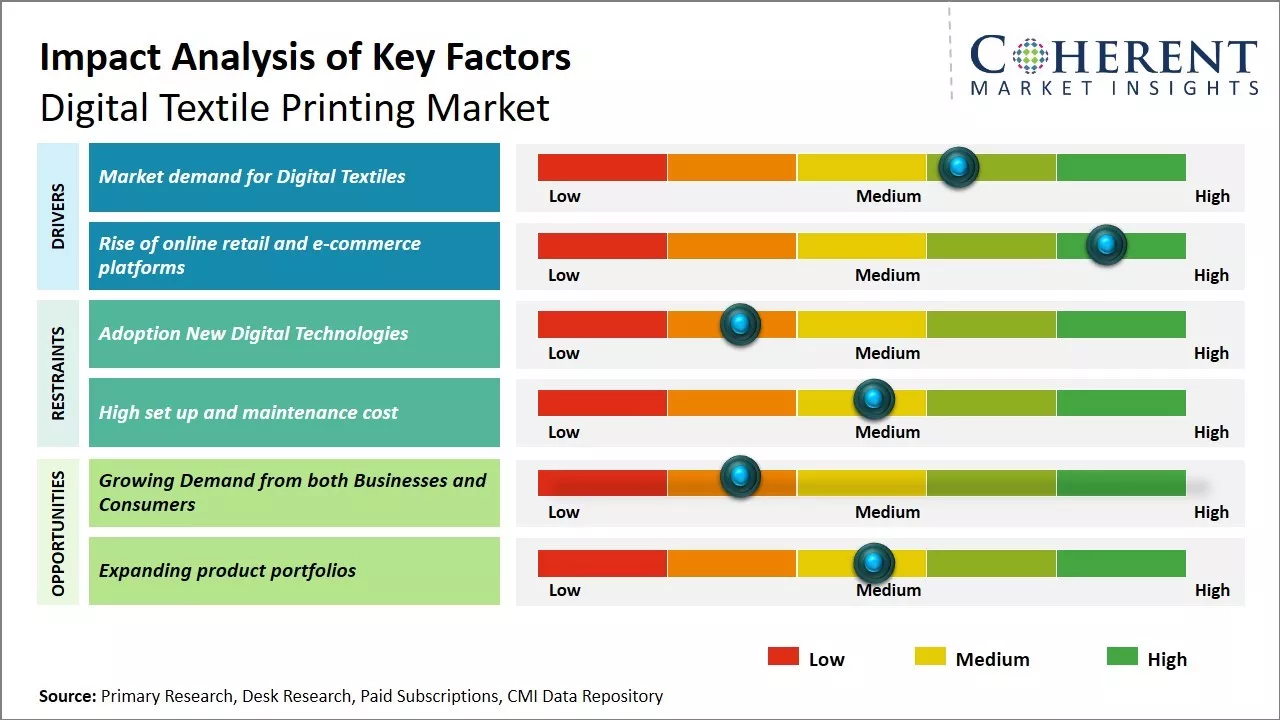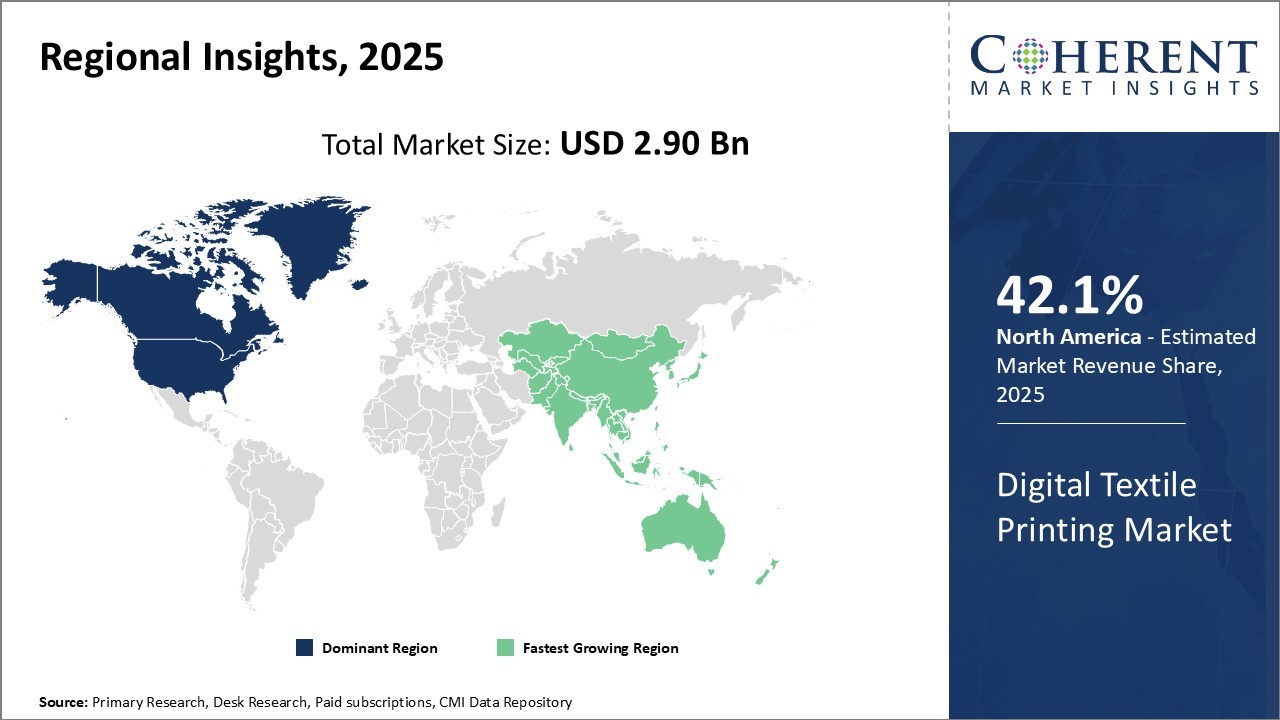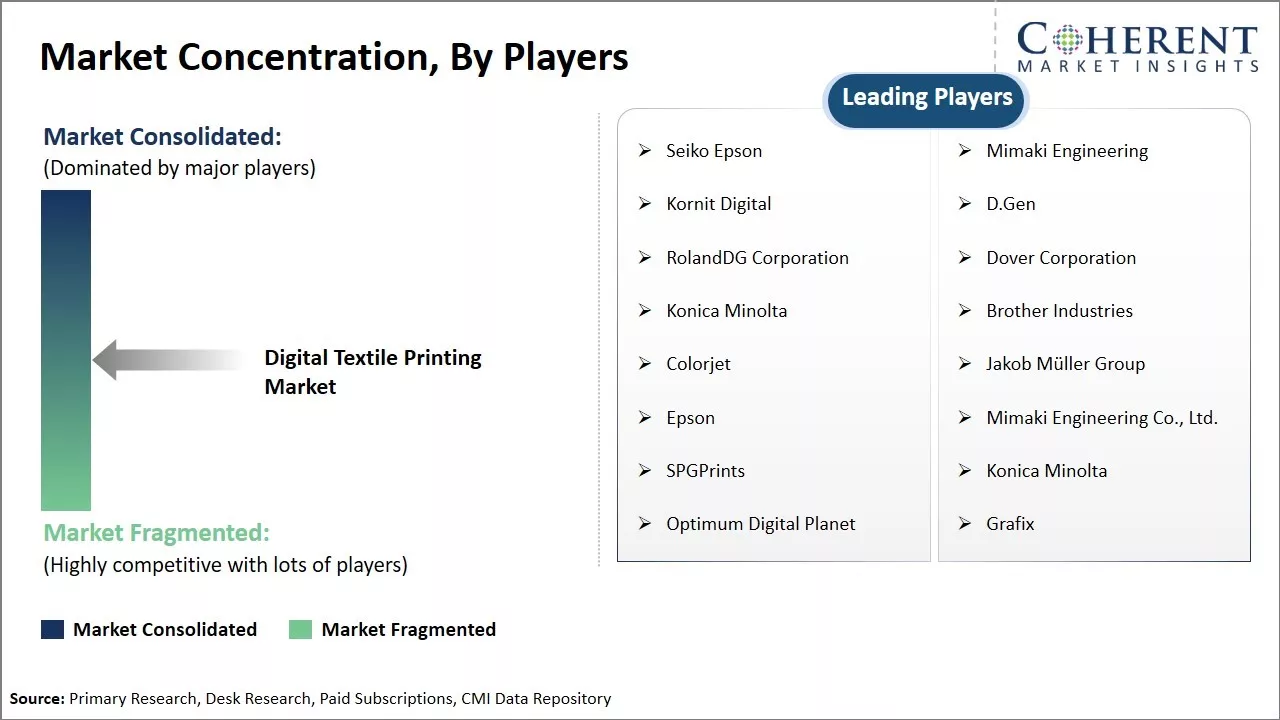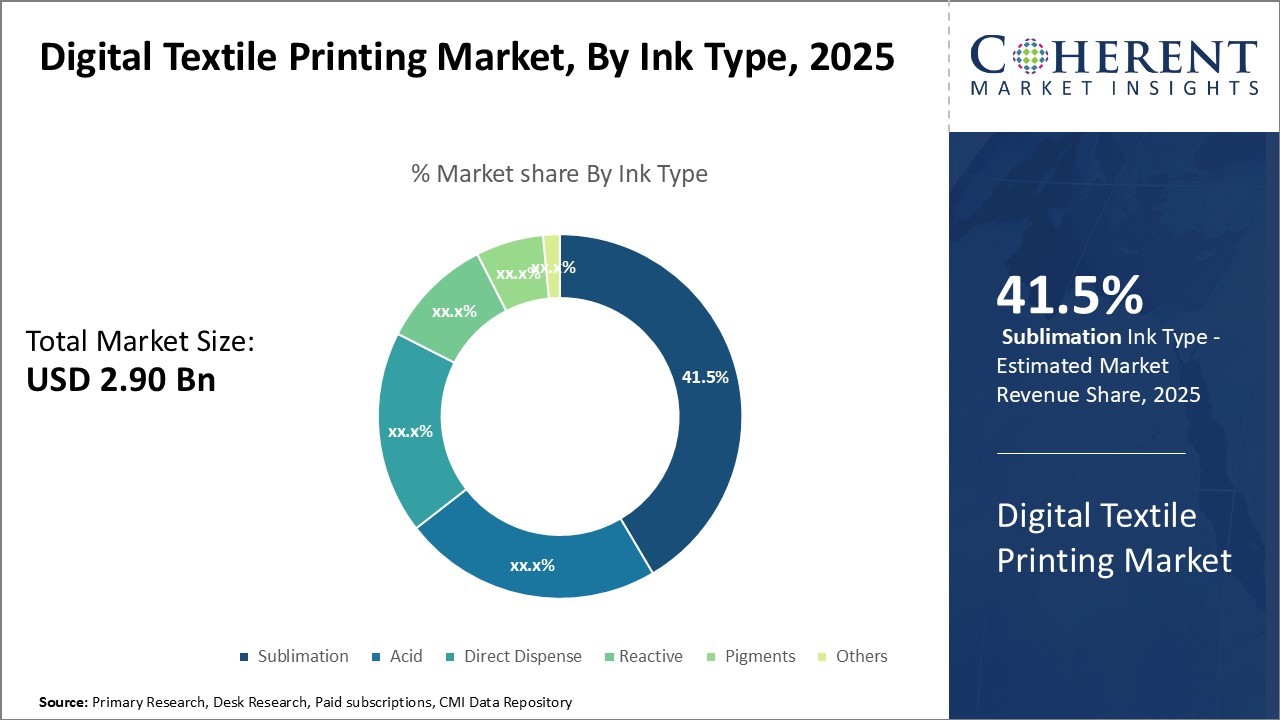Digital Textile Printing Market Size and Trends
Global digital textile printing market share is estimated to be valued at USD 2.90 Bn in 2025, and is expected to reach USD 4.75 Bn by 2032, growing at a compound annual growth rate (CAGR) of 7.3% from 2025 to 2032.
Key Takeaways
- Based on ink Type, the sublimation segment leads the market, holding an estimated share of 41.5% in 2025 owing to the versatility of sublimation dyes.
- Based on Substrate, the cotton segment leads the market, holding an estimated share of 41.7% in 2025, due to its natural affinity with various printing technologies.
- Based on Printing Process, the direct to garment segment dominated the market holding an estimated share of 41.73% in 2025 owing to the operational efficiencies it offers.
- Based on Operation, the multi-pass segment leads the market holding highest share in 2025, supported by its cost-effectiveness and flexibility.
- Based on Application, the clothing/Apparel segment is estimated to dominate the global digital textile printing market with largest share in 2025, owing to the rapid customization in the fashion industry.
- Based on Region, North America is expected to lead the market, hodling a share of 42.1% in 2025. While, Asia Pacific is anticipated to be the fastest-growing region during the forecast period.

To learn more about this report, Download Free Sample
Market Overview
Global digital textile printing market demand is expected to witness significant growth over the forecast period due to rising demand for customized and personalized textile printing across various end-use industries. Growing adoption of digital printing over traditional screen and analog printing due to benefits such as reduced wastage, on-demand printing, versatility and shorter lead time is expected to boost demand for digital textile printing. Furthermore, expanding textile industry and rising demand for advanced textile from fashion and interior décor industry are expected to drive the digital textile printing market in the near future. However, high capital investment and operational costs associated with digital printers may hinder the growth of the market to some extent over the forecast period.
Current Events and their Impact on the Digital Textile Printing Market
|
Current Events |
Description and its Impact |
|
Major Regulatory Shifts in Sustainability Frameworks |
|
|
Geopolitical Trade Policy Revisions |
|
Uncover macros and micros vetted on 75+ parameters: Get instant access to report
Role of Artificial Intelligence (AI) in the Digital Textile Printing Market
The integration of AI into digital textile printing market is revolutionizing digital printing by automating tasks, improving efficiency, and personalizing the printing experience. AI-powered tools can enhance text recognition, optimize print workflows, and even create personalized print products. This includes features like automatically correcting images, recognizing handwritten text, and recommending optimal print settings.
In May 2025, Kornit Digital launched its Apollo high-throughput direct-to-garment (DTG) printing system at FESPA 2025, aiming to bridge traditional screen printing and digital on-demand production. Featuring automation, integrated curing, and a single-operator workflow, Apollo achieves up to 400 garments per hour, supporting mass customization while reducing costs and waste.
Digital Textile Printing Market Insights, By Ink Type
Sublimation Acquires the Largest Market Share
In terms of ink type, sublimation segment contributes the 41.5% share of the market in 2025 owing to the versatility of sublimation dyes. Sublimation inks allow for vibrant colors and high color saturation due to the properties of sublimation dyes. These dyes can be heated to change from solid to gas without passing through the liquid phase, which embeds the colors deeply in the fabric fibers. This ensures colors remain fast over time, and are resistant to washing and rubbing. The wide range of sublimation dyes available also provide printers with greater scope for creativity and customization as compared to other ink types. New developments in dye chemistry are further expanding color gamuts. Sublimation inks are also ideal for printing on polyester and poly-blend fabrics most commonly used in apparel, as the dyes bond well with these materials.
Sun Chemical has launched ElvaJet Topaz SC, a cutting-edge sublimation ink designed for digital textile production. Built for Kyocera printheads, it offers an expanded operating window for precision jetting and enhanced cross-system compatibility.
Digital Textile Printing Market Insights, By Substrate
Cotton Acquires the Largest Market Share
In terms of substrate, cotton segment contributes the 41.7% share of the market due to its natural affinity with various printing technologies. Being a natural fiber, cotton has an inherent porosity that makes it absorbent to inks and dyes. This facilitates greater color yield and impact. Advances in ink and pretreatment formulations have optimized printing outcomes on cotton. Its breathability and skin-friendly qualities have also cemented cotton's popularity in apparel. A large portion of the apparel market still relies on cotton due to consumer preferences for the material's comfort. As such, cotton enables high-quality, vibrant printing and remains a worthy substrate.
In February 2025, Premier Digital Textiles introduced a new recycled cotton fabric as part of its updated “Essentials” collection of 31 sustainable substrates tailored for digital textile printing. The Essentials Range, which also features organic cottons and recycled polyesters, supports eco-conscious textile supply chains and reduces environmental impact by repurposing recovered fibers from garments and furnishings.
Digital Textile Printing Market Insights, By Printing Process
Direct to Garment Segment Holds the Dominant Market Share
In terms of printing process, direct to garment segment contributes the 41.73% share of the market owing to the operational efficiencies it offers. Direct to garment printing eliminates intermediate steps between fabric printing and garment manufacturing. It allows printing customized designs directly onto readymade or semi-finished garments. This integrated process is faster and reduces costs compared to traditional transfer printing methods. It enables on-demand printing and minimum fabric wastage. Better colorfastness is also achieved through direct contact between ink and fabric. The advent of multi-needle inkjet printers capable of printing on complex garment contours has boosted the popularity of direct to garment printing. A D2G tray kits simplify workflow, reduce waste, and facilitate bespoke manufacturing, marking a significant leap toward scalable, eco‑friendly fashion.
In April 2024, Stratasys launched its new Direct‑to‑Garment (D2G) feature for the J850 TechStyle 3D printer, enabling full‑color, multi‑material 3D printing directly onto fully assembled garments such as denim, cotton, polyester, and linen. The company showcased the Urban Tattoo collection—featuring custom designs by prominent designers at Texprocess Frankfurt, demonstrating seamless integration of personalization and sustainability in fashion.
Digital Textile Printing Market Insights, By Operation
Multi-Pass Segment Acquires the Largest Market Share
In terms of operation, the multi-pass segment is expected to contribute the highest digital textile printing market share in 2025, due to its cost-effectiveness and flexibility. Multi-pass printing process operation is considered as the leading technology worldwide. Along with being cost-effective and flexible, multi-pass printing process also has the ability to correct printing errors over several passes, making it ideal for diverse application from fashion to home décor. Multi-pass printing process is a digital printing process where the printhead makes multiple passes over the same area f the substate to build up the final image. Multi-pass printing is often used to improve print quality, especially for finer details and smoother color gradients.
In February 2025, Indian printing technology firm Monotech Systems unveiled the PixelGlow Vertex, a fully automated B2-size, multi-pass digital UV embellishment and foiling system, at PrintPack 2025. It is designed to deliver high-gloss raised and metallic effects, the system features Ricoh printheads, supports paper weights from 170–600 GSM, and processes up to 300 A3+ sheets per hour. Its built-in AI-driven scanner ensures precise registration and includes a foil-saving mechanism to reduce operational costs.
Digital Textile Printing Market Insights, By Application
Clothing/Appeal Holds the Dominant Share
In terms of application, the clothing/appeal segment is expected to contribute the largest share of the market in 2025, driven by the fashion industry's need for rapid customization, small-batch production, and sustainability. In the fashion industry the digital textile and apparel printing is optimizing the production by enabling rapid design iterations and reducing waste, especially in e-commerce and fast fashion. Digital textile printing is gaining popularity in the clothing industry due to its versatility, speed, and customization options, all while offering a more sustainable approach compared to traditional methods.
In February 2025, ColorJet India Ltd launched its Fab Jet Pro, a groundbreaking digital textile printer engineered for high-volume production. Capable of processing up to 13,000 sq m of fabric daily, the new model supports 8-color configurations and delivers print speeds reaching 654 m²/hr, making it ideal for applications like home textiles, apparel, and soft signage. The launch features industrial-grade Kyocera and Konica Minolta print heads, Fab Jet Pro emphasizes precision, wide-format versatility, and eco-friendliness.
Regional Insights

To learn more about this report, Download Free Sample
North America Digital Textile Printing Market Analysis & Trends
North America has established itself as the dominant region in the global digital textile printing market with a 42.1% share in 2025. The presence of leading manufacturers and technology providers in the U.S. and Canada has allowed the region to develop strong expertise in the field, according to the latest digital textile printing market research. Major brands have their production and R&D facilities based in North America in order to gain early access to the latest innovations. As a result, textile printers developed for the North American market tend to be the most advanced globally, with the highest level of features and capabilities. In April 2024, Epson showcased its SureColor F Series at ASEAN Fashion Week, spotlighting North America–developed sustainable material technologies. As e-commerce and fast fashion drive demand for on-demand printing, North American firms leverage IoT-enabled print heads and AI color management to stay ahead in innovation and market trends. This is further contributing to the digital textile printing market demand.
Asia Pacific Digital Textile Printing Market Analysis & Trends
The Asia Pacific region has emerged as the fastest growing market for digital textile printing worldwide. Having the largest textile manufacturing base globally means the region stands to gain immensely from the technology's benefits. Countries like India and China are aggressively pushing for adoption of digital printing to enhance productivity and turnaround times of their export-oriented industries. Local governments provide subsidies and incentives to encourage printers' upgrades as well as establishment of new printing facilities.
For instance, in April 2025, India-based Vee Kay Enterprises launched a high-speed Make in India digital textile printing machine with Ricoh Gen 6 printheads, highlighting regional innovation. This aligns with the broader digital textile printing market forecast, which anticipates strong momentum from Asia Pacific through the decade.
Digital Textile Printing Market Outlook Country-Wise
The United States Digital Textile Printing Market Trends
The U.S. market for digital textile printing is driven by flexibility, customization options and environmental benefits. The digital textile printing in U.S. allows for on-demand printing of intricate designs, quick turnaround times, and personalized products, all while reducing waste and water consumption compared to traditional methods. For instance, in January 2024, Epson America expanded its SureColor F‑Series lineup, launching a versatile direct‑to‑garment (DTG) printer tailored for artisanal and small business operators.
China Digital Textile Printing Market Trends
China’s market for digital textile printing is witnessing significant growth in recent years, driven by the country’s ability to produce customized, high-quality designs quickly and efficiently, aligning with the country's large textile manufacturing industry and growing demand for personalized and sustainable products. The technology also reduces waste, minimizes water consumption, and offers flexibility for small-batch production, making it an attractive option for both manufacturers and consumers. Digital fabric printing is gaining a strong foothold in the Yangtze River Delta region, a hub for textile production and exports in China. For instance, at the ITCPE 2024 expo from May 20–22, exhibitors showcased cutting-edge digital textile printing machines amid escalating global demand. A recent IDC report revealed China’s digital textile printing machine revenue surpassed USD 66 million in Q3 2023, up 17.2% year-over-year. This is further propelling the digital textile printing market share.
Italy Digital Textile Printing Market Trends
Italy continues to be a key market for digital textile printing in Europe, driven by the country’s ability to meet the demands of the luxury fashion industry for high-quality, customized designs with faster turnaround times. The region's established textile production industry has embraced digital technologies to stay competitive and offer sustainable manufacturing solutions. The Como district in North Italy, famous for high-quality printing on silk across the world has led Italian market from the front and realized its benefits. For instance, in March 2024, Dover Industries Italy debuted its latest digital printing innovations at FESPA Global Print Expo, spotlighting its new Color Pack calibration software alongside a complete Soft Signage solution. The integrated setup features the high-speed JP4 Evo 3.2 printer, Kiian Digital K‑ONE dye-sub ink, and Color Pack—designed to enhance color accuracy, ink efficiency, and productivity across paper and non-elastic fabric markets.
Digital Textile Printing Market Driver
Market demand for Digital Textiles
The demand for digital textile has been steadily increasing over the years. With digital printing, short run and on-demand printing of textiles has now become possible, allowing for greater personalization and customization of textile products. This has opened up new opportunities for low volume printing which was previously not feasible through traditional textile printing methods. Consumers now want clothing and home furnishing products that reflect their individual tastes and personality. Digital textile printing helps to meet this need by enabling on-demand printing of different designs, in small batches if required. Apparel manufacturers and textile retailers have been quick to recognize the potential of digital printing to meet this demand. These manufacturers have started offering a wide variety of fashion products printed digitally, featuring unique, eye-catching patterns and graphics. This has captured consumers' interest and driven their preferences towards digitally printed textiles. The appeal of bespoke, exclusive textile products tailored to individual tastes and interests is a major factor boosting demand for digital textile printing technology.
Market Concentration and Competitive Landscape

To learn more about this report, Download Free Sample
Recent Developments
- In April 2025, Vee Kay Enterprises, a pioneer in India’s digital printing sector, launched a new Make in India digital textile printing machine designed for high-speed, full-color production on knitted and woven fabrics. The new model is equipped with RICOH Gen 6 printheads, offering around 130–140 m²/hour output across multiple color options, and is tailored to meet the expanding needs of India’s textile and apparel industries.
- In February 2025, Mimaki Engineering Co. launched the Tx330-1800 and Tx330‑1800B, its latest direct textile inkjet printers that minimize water use in fabric printing. Utilizing only printing and heat treatment, these models eliminate the need for dyeing chemicals and wastewater infrastructure, addressing environmental concerns tied to traditional textile processes.
- In July 2024, Digital textile-printing specialist Orange O Tec Pvt Ltd will launch its fully indigenous Fabpro 1i printing machine at Gartex New Delhi on August 1. The “Made‑in‑Bharat” model uses a Ricoh eight‑head system to deliver high-speed output up to 2,200 linear meters per day within a compact footprint, promising superior quality and efficiency. Developed entirely in India, Fabpro 1i embodies the company's shift from importer to manufacturer, offering a complete digital textile-printing ecosystem with inks, software, and professional support.
- In June 2023, Chinese textile hardware innovator Atexco unveiled its new VEGA9180DI intelligent digital textile printer at ITMA 2023 in Milan. It is designed for industrial-scale applications, the printer delivers up to 15,000 m of printed fabric per day and features advanced systems including quadruple print-head protection, temperature control, water-saving belt cleaning, and auto-centering feed.
- In May 2022, Seiko Epson launched the Monna Lisa 8000 printer, a direct-to-fabric printer specifically targeted at North America. The acquisition of For.Tex and F.lli Robustelli has allowed Epson to take care of the entire textile printing process, from start to finish, and strengthen its position in North America.
- In August 2022, Roland DG Corporation, a manufacturer and distributor of advertising and signage inkjet printers and 3D manufacturing tools, announced the expansion of its services by constructing a new building at its Thailand factory managed by Roland Digital Group Thailand Ltd in Samutsakhon, Thailand.
Market Report Scope
Digital Textile Printing Market Report Coverage
| Report Coverage | Details | ||
|---|---|---|---|
| Base Year: | 2024 | Market Size in 2025: | USD 2.90 Bn |
| Historical Data for: | 2020 To 2024 | Forecast Period: | 2025 To 2032 |
| Forecast Period 2025 to 2032 CAGR: | 7.3% | 2032 Value Projection: | USD 4.75 Bn |
| Geographies covered: |
|
||
| Segments covered: |
|
||
| Companies covered: |
Seiko Epson, Mimaki Engineering, Kornit Digital, D.Gen, RolandDG Corporation, Dover Corporation, Konica Minolta, Brother Industries, Colorjet, Jakob Müller Group, Epson, Mimaki Engineering Co., Ltd., SPGPrints, Optimum Digital Planet, Grafix |
||
| Growth Drivers: |
|
||
| Restraints & Challenges: |
|
||
Uncover macros and micros vetted on 75+ parameters: Get instant access to report
Rise of online retail and e-commerce platforms
Rising prominence of online retail and e-commerce is expected to drive the market growth. In the digital era, online retail channels have proliferated across industries including textiles and apparel. The consumers are increasingly turning to e-commerce sites and brands' own websites to shop for their fashion and home ware needs. For manufacturers and retailers catering to this lucrative online retail market, digital printing offers a highly advantageous production method. It enables on-demand printing of variable designs in-house, without long setup times or high minimum order quantities associated with traditional textile printing methods. This makes it simpler for e-commerce businesses to offer a wide variety and constant replenishment of unique printed textile products on their websites and keep up with fast changing consumer demands and trends.
Digital textile printing is highly suitable for producing small batches of clothing, furnishings and other items with personalized or limited edition prints to maintain customer interest on e-stores. The synergies between digital textile printing and online retail channels are compelling the rapid adoption of this technology for serving the evolving needs of digital commerce.
Digital Textile Printing Market Opportunities
Growing Demand from both Businesses and Consumers
On-demand printing allows for lower minimum runs and more design flexibility. This ability to personalize and customize textiles efficiently meets growing demand from both businesses and consumers. As the technologies advance, digital printing will be capable of replicating more complex designs and patterns on a wider range of fabrics. It also offers benefits around reducing textile waste and being more environmentally sustainable compared to traditional methods.
Analyst Opinion (Expert Opinion)
The digital textile printing (DTP) market value is no longer riding on incremental shifts—it is undergoing a structural transformation driven by technological convergence, sustainable mandates, and production re-localization. The notion that digital printing is simply a "faster alternative" to analog techniques is outdated; it is, in fact, a redefinition of the entire value chain in textile manufacturing.
In fast fashion and short-run segments, digital is now the default. Companies like Zara and H&M, which operate on compressed timelines, have shifted significant portions of their production to digital platforms to reduce lead times from 6–9 weeks to under 7 days. Brands are no longer willing to stockpile SKUs with uncertain demand. Digital textile printing, especially via pigment-based inks, allows same-day sampling and near-immediate design iteration—making analog’s long setup times obsolete in this domain.
The shift from dye-sublimation and reactive inks toward pigment inks is not a minor chemistry debate—it's a sign of market maturity. Pigment-based digital printing eliminates pre- and post-treatment steps, reducing water usage by up to 95% and energy consumption by 60%, according to data published by Kornit Digital and EFI Reggiani. This makes pigment ink not just a “green” alternative but also the only viable option for decentralized, micro-factory-based production in the West.
Market Segmentation
- Ink Type Insights
- Reactive
- Acid
- Direct Dispense
- Sublimation
- Pigments
- Others
- Substrate Insights
- Cotton
- Polyester
- Nylon
- Wool
- Others (Silk, linen, rayon, etc.)
- Printing Process Insights
- Direct to Fabric
- Direct to Garment
- Operation Insights
- Single Pass
- Multi-Pass
- Application Insights
- Clothing/Apparel
- Home Décor
- Soft Signage
- Others (Automotive textiles, healthcare textiles, etc.)
- Regional Insights
- North America
- U.S.
- Canada
- Latin America
- Brazil
- Argentina
- Mexico
- Rest of Latin America
- Europe
- Germany
- U.K.
- Spain
- France
- Italy
- Russia
- Rest of Europe
- Asia Pacific
- China
- India
- Japan
- Australia
- South Korea
- ASEAN
- Rest of Asia Pacific
- Middle East & Africa
- GCC
- Israel
- Rest of Middle East & Africa
Key Players Insights
- Seiko Epson
- Mimaki Engineering
- Kornit Digital
- D.Gen
- RolandDG Corporation
- Dover Corporation
- Konica Minolta
- Brother Industries
- Colorjet
- Jakob Müller Group
- Epson
- Mimaki Engineering Co., Ltd.
- SPGPrints
- Optimum Digital Planet
- Grafix
Sources
Primary Research Interviews from the following stakeholders
Stakeholders
- Interviews with textile printers, dye manufacturers, printhead suppliers, apparel brands, home textile producers, and advertising agencies across key textile hubs worldwide.
Databases
- World Trade Organization (WTO)
- UN Comtrade Database
- Ministry of Textiles (India)
- Eurostat
- China General Administration of Customs
- U.S. Bureau of Economic Analysis
- Korea Customs Service
- Japan External Trade Organization (JETRO)
- Directorate General of Commercial Intelligence and Statistics (DGCIS), India
Magazines
- Textile World
- Digital Textile Magazine
- Ink World
- Textile Today
- Print Week
- Textile Insighs
- Specialty Fabrics Review
- Printing Impressions
- WTiN (World Textile Information Network)
Journals
- Journal of Textile Science & Engineering
- Coloration Technology
- Journal of Industrial Textiles
- Surface Coatings International
- Textile Research Journal
- The Journal of the Textile Institute
Newspapers
- The Economic Times – Textile and Apparel
- Business Standard – Manufacturing & Innovation
- The Hindu Business Line – Indian Textile Industry
- Nikkei Asia – Printing Equipment and Supply Chain
- South China Morning Post – Asian Textile Market
- Financial Times – Retail and Apparel Sector
Associations
- India ITME Society
- Federation of Indian Chambers of Commerce and Industry (FICCI) – Textiles
- International Textile Manufacturers Federation (ITMF)
- Confederation of Indian Industry (CII) – Textile Machinery Forum
- Textile Machinery Manufacturers’ Association (India)
- The Society of Dyers and Colourists (SDC)
- American Association of Textile Chemists and Colorists (AATCC)
- European Apparel and Textile Confederation (EURATEX)
Public Domain Sources
- Ministry of Textiles (Government of India)
- National Institute of Fashion Technology (NIFT) Reports
- U.S. International Trade Commission (USITC) – Apparel & Textile Sectors
- Ministry of Industry and Information Technology (MIIT), China
- Ministry of Economy, Trade and Industry (METI), Japan
- Reserve Bank of India (RBI) – Manufacturing Sector Reports
- EU Commission – Sustainable Textiles and Circular Economy Initiatives
- India Brand Equity Foundation (IBEF) – Textile Sector Updates
- NITI Aayog – Reports on Industrial Printing and Digitalization
- India Investment Grid – Textile Manufacturing Projects
Proprietary Elements
- CMI Data Analytics Tool, and Proprietary CMI Existing Repository of information for last 8 years
Share
Share
About Author
Yash Doshi is a Senior Management Consultant. He has 12+ years of experience in conducting research and handling consulting projects across verticals in APAC, EMEA, and the Americas.
He brings strong acumen in helping chemical companies navigate complex challenges and identify growth opportunities. He has deep expertise across the chemicals value chain, including commodity, specialty and fine chemicals, plastics and polymers, and petrochemicals. Yash is a sought-after speaker at industry conferences and contributes to various publications on topics related commodity, specialty and fine chemicals, plastics and polymers, and petrochemicals.
Missing comfort of reading report in your local language? Find your preferred language :
Transform your Strategy with Exclusive Trending Reports :
Frequently Asked Questions
EXISTING CLIENTELE
Joining thousands of companies around the world committed to making the Excellent Business Solutions.
View All Our Clients

